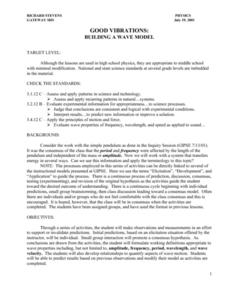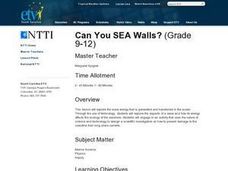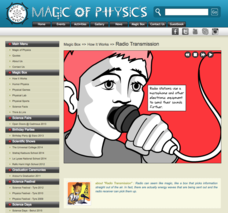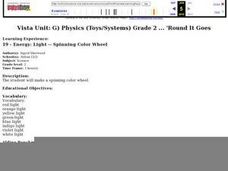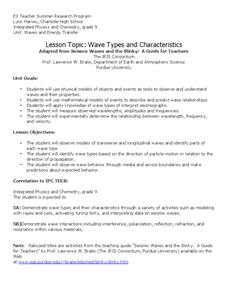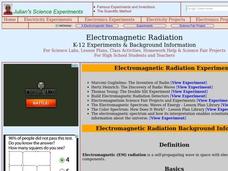Curated OER
Good Vibrations: Building a Wave Model
Students assess and apply recurring patterns in natural systems. They evaluate the wave properties of frequency, wavelength, and speed as applied to sound. Students develop a relationship to quantify aspects of wave motion. They predict...
Curated OER
Can You SEA Walls?
Students explore how wave energy that is generated and transferred in the ocean. They explore the aspects of a wave and how its energy affects the ecology of the seashore. Students engage in an activity that uses the nature of science...
DiscoverE
Slinky® Science
Toys are great for learning about physics. Scholars use Slinky® toys to study Newton's laws of motion and types of energy. After a little play, they then model longitudinal and transverse waves with the Slinky® toys.
Magic of Physics
Radio Transmission
Radio waves are all around us! How do they transmit sound? Using an interactive, scholars examine how songs travel through the air. The resource explains the process from the radio station, to signal towers, to the radio unit. A look at...
Cornell University
Diffraction Demystified
Study diffraction patterns using CDs and DVDs! Scholars measure the diffraction patterns of a light wave as it hits a CD or DVD. Using the information, they can measure the distance between the tracks.
Curated OER
Physics: Light and Sound
Students explore the concepts of light waves and sound waves. In this physics lesson, students complete activities that require them to investigate how light and sound waves travel.
Curated OER
Properties of Waves
Third graders observe and investigate wave properties and compare the properties of particles and waves. They fill a pie pan half full with water, place a toothpick in the center of the pie pan, then drop a marble into the pan and...
Curated OER
The Energy of Light
Young scholars discuss different ways engineers use light. In this engineering lesson, students are introduced to the properties of light and the way light is used. They view a demonstration of light waves using a slinky, and practice...
Curated OER
What Wavelength Was That?
A combination of informative text, photos, and graphics comprise this sharp show on electromagnetic radiation. Some slides mention hands-on activities for demonstrating concepts, so if you want to include them you will need to figure out...
CK-12 Foundation
Preschool Races
What determines which ball rolls the fastest — the weight, the radius, the material, or something else? Scholars select two balls to race down the inclined plane, determining their material and radius. As they race, the simulation graphs...
Curated OER
Making Waves, Making Music, Making Noise
Students construct "talking cans" and instruments to explain how vibration of objects produces various sounds.
Curated OER
Sound Waves
Students explore sound. In this "sound" science lesson, students define sound and explain how sound travels. Students experiment with paper cups and string to conclude how sound travels. Students research a chosen aspect of sound with a...
Curated OER
Energy: Light -- Spinning Color Wheel
Second graders make spinning color wheels to determine how energy effects what colors look like. They paint or color a color wheel with the seven colors of the spectrum. Next, the spin the wheel to determine what happens. In order to...
Curated OER
Modern Physics, The Quantum
In this physics worksheet, students examine the relationship between the discrete and continuous spectrum alongside other concepts for the 9 questions.
Urbana School District
Light
You matter, unless you multiply yourself by the speed of light ... then you energy. Presentation covers the behavior of light as both a wave and a particle, light versus sound, space travel, why objects have colors, depth perception,...
Curated OER
Wave Types and Characteristics
Ninth graders identify the different parts of a wave. In this physics instructional activity, 9th graders observe wave behavior as it travels through a boundary. They determine the relationship between wavelength, frequency and...
Curated OER
Coasts and Reefs: Shallow Marine Processes
A more thorough presentation on coastal systems would be difficult to find! Detailed diagrams illuminate the offshore, shoreface, foreshore, and backshore zones of beach. The sources and movement of sediments along the coastline...
Curated OER
How Do You Light Up Your World?
A tremendous presentation on the properties of light. Young scientists are treated to slides which share a lot of fascinating information about light. This impressive PowerPoint is filled with great photos, graphics, and discussion...
Curated OER
Listening Devices
Learners design and construct a listening device that will allow them to listen to the sound generated by specific object inside a box.
Curated OER
Sounds Like Great Science!
A phenomenal lesson plan on sound is here for your third graders! In it, learners engage in hands-on activities, watch video, take part in Internet activities, and complete tasks in cooperative groups in order to explore the world of...
Curated OER
Electromagnetic Radiation
Students explore the nature of electromagnetic spectrum through a series of experiments. In this physics lesson, students determine how light behaves under certain circumstances. They explain how humans perceive colors.
Curated OER
Building Polymer Cup Speakers
Students investigate sound waves and they build audio speakers. In this audio speakers and sound lesson, students explore how to make quality audio speakers. As a team they build their own speakers to have clarity in sound, quality in...
Curated OER
Differential Thermal Calorimetry
Students access prior knowledge of infrared rays, ultraviolet rays, gamma rays, x-rays and cosmic waves. In this electromagnetic waves lesson, students hold a mock trial electromagnetic spectrum. Students present characteristics of the...
Curated OER
The Science of Sound
In this explanation of sound worksheet, students discover what sound is, how different sounds are made, frequency, how sound travels, how we hear, and a summarization. In this physical science worksheet, students answer ten comprehension...


